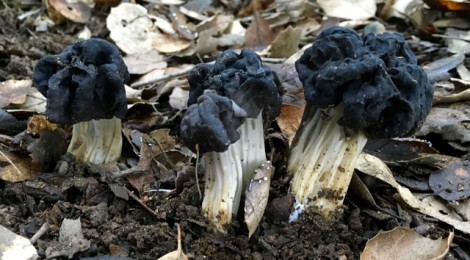
Elfin Saddle fungus found along the American River Parkway
If you take a walk along the American River Parkway in the early spring after a rain, you might glimpse one of the Parkway’s more other worldly residents. Generally overlooked by most visitors, these unusual inhabitants are an important group of soil organisms called mycorrhizal fungi.
One of these fungi, that is, it’s fruiting structure, is pictured above. It’s called the Elfin Saddle Fungus (Helvella dryophila) and it’s a species that is known to be mycorrhizal on oaks. Not surprisingly, this one was poking its distinctive fruiting body up through the leaves of live oak.
The fruiting body is the reproductive structure of the fungus. Releasing its spores into the surrounding environment, this is how the fungus reproduces. You might think of a fruiting body as analogous to a flower on a plant; it’s the reproductive part, but not the main body of the organism.
You have to look below ground to find the main body of a mycorrhizal fungus. Below ground the fungus forms an extensive network of filamentous hyphae that consume dead organic matter (e.g., leaves, fruiting structures, branches, etc.). In so doing, the fungus behaves like many other soil fungi by helping to decompose in soil formation by breaking down plant materials
But what makes these fungi so interesting and unique in the fungal kingdom is that they form a very close and beneficial relationship with certain plants called a symbiotic mutualism. It’s a mutualism because both the plant and fungus benefit from the relationship. And it’s a symbiotic mutualism because the fungus actually colonizes the inside of the plant’s root system. The plant host receives increased access to water and nutrients provided by the fungus, and in turn the mycorrhizal fungus receives carbohydrates from the plant that it obtained by photosynthesis.
Though this kind of biological interaction between entirely different species might sound unusual, it’s actually quite common. In fact, over 90% of land plants are colonized by these beneficial fungi!
This spring semester graduate students in the Department of Biological Sciences’ Methods in Ecology, Evolution and Conservation (Bio 221B) course are conducting a survey of these fungi along a stretch of the American River Parkway.
While scouting the American River Parkway near Sacramento State for sites to conduct the survey, the class came across a small cluster of Elfin Saddle Fungus (Helvella dryophila) that were fruiting beneath the canopy of a large live oak (Quercus agrifolia). With its black gnarled cap and grayish white stalk, the Elfin Saddle is a striking sight to behold – so otherworldly you might think it was straight out of a sci-fi movie!
As far as I can tell, this appears to be the first time anyone has ever conducted a survey for these fungi along this stretch of the Parkway. Graduate students in the course are using both field and molecular techniques to identify and quantify colonization and diversity of mycorrhizal species along this stretch of American River.
Running along the Sacramento State campus for a stretch, the American River Parkway certainly offers a wonderful resource for learning and occasionally an other worldly experience for students of biology!


